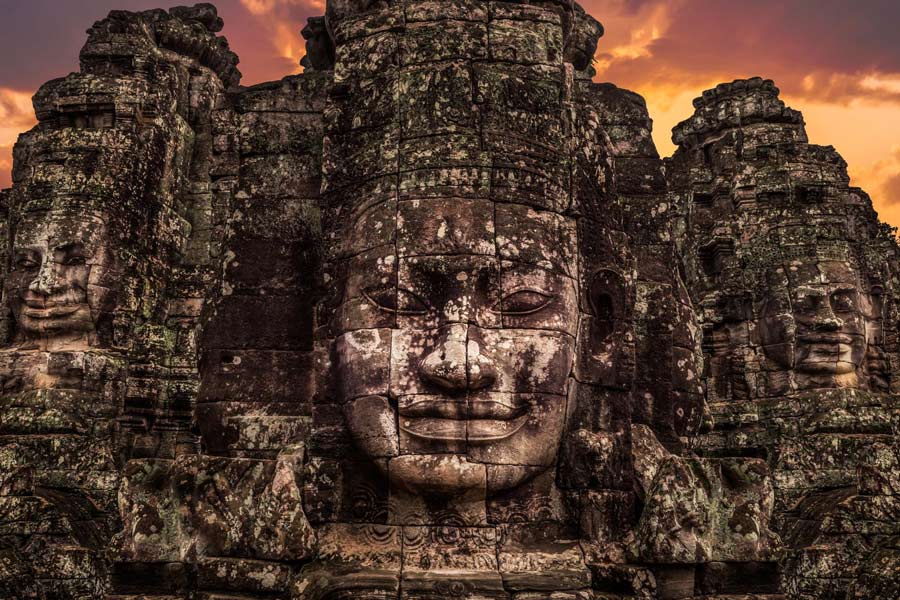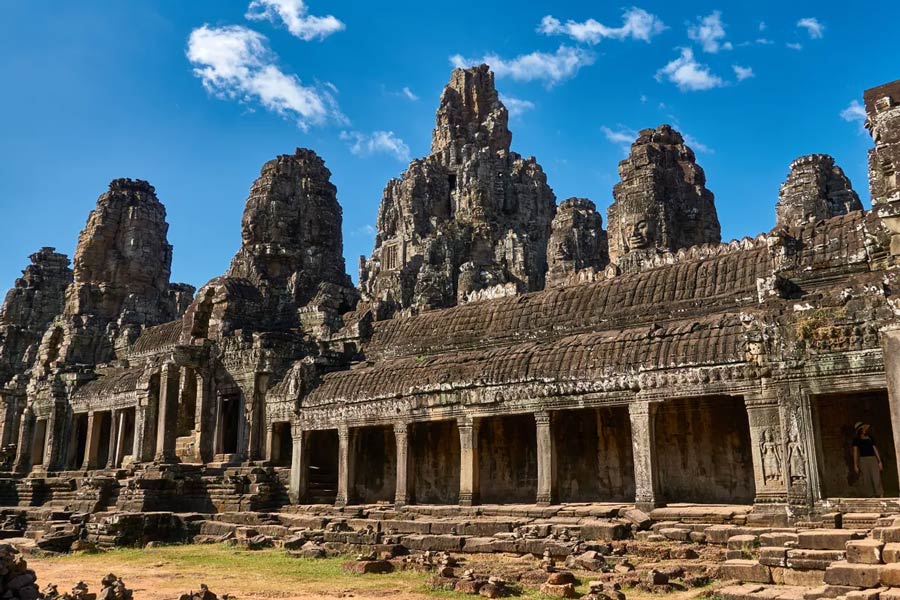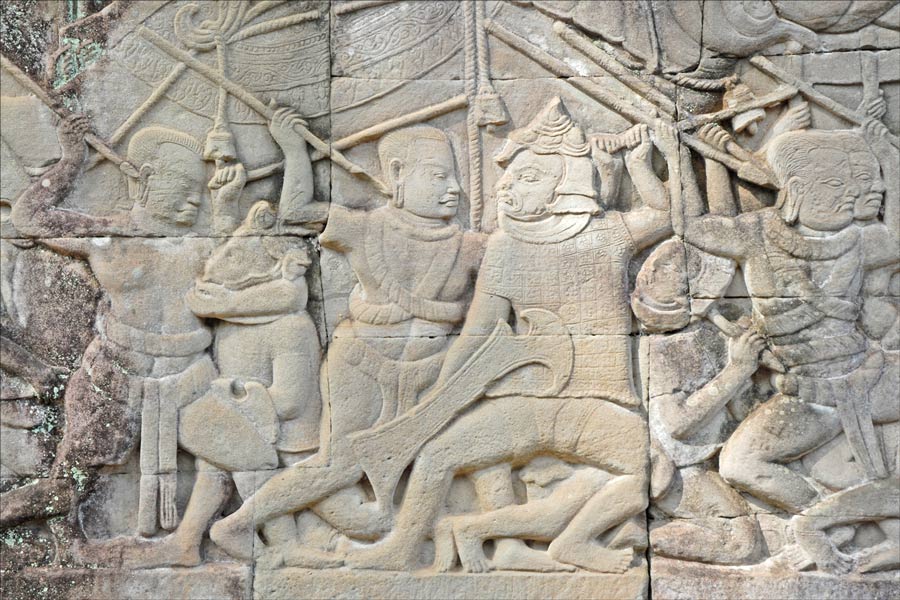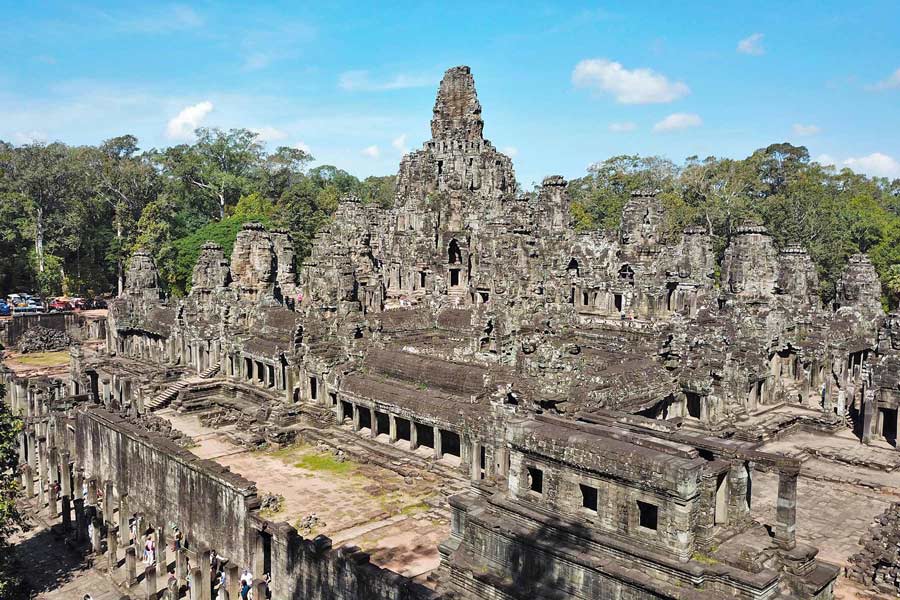Bayon Temple

Bayon Temple, situated at the heart of the ancient city of Angkor Thom in Cambodia, stands as a remarkable testament to Khmer architecture and cultural splendor. Its most distinctive feature is the multitude of serene stone faces adorning its towers, approximately 216 in total, believed to represent the bodhisattva Avalokiteshvara or the king himself. These faces, along with extensive bas-reliefs depicting scenes from Khmer life, contribute to the temple's enigmatic aura. Serving as the symbolic representation of Mount Meru, Bayon is an integral part of the larger Angkor Thom complex and a UNESCO World Heritage site. Ongoing restoration efforts underscore the significance of preserving this architectural masterpiece, allowing visitors to immerse themselves in the rich history and cultural heritage of the Khmer Empire.
Bayon Temple's history is intertwined with the rise and fall of the Khmer Empire in Cambodia. Built in the late 12th or early 13th century, Bayon stands as a testament to the architectural and cultural achievements of the Khmer civilization during its zenith. Commissioned by King Jayavarman VII, the temple was part of the larger Angkor Thom, which served as the capital of the empire.
King Jayavarman VII, who ruled from 1181 to around 1218, initiated the construction of Bayon as a state temple. The temple was dedicated to Mahayana Buddhism, reflecting the king's religious affiliations. The central sanctuary of Bayon symbolizes Mount Meru, a sacred mountain in Hindu and Buddhist cosmology. The temple's unique feature is the multitude of massive stone faces adorning its towers, thought to represent the compassionate bodhisattva Avalokiteshvara or even the likeness of King Jayavarman VII himself.
Bayon underwent changes in religious orientation over the years. While it began as a Buddhist temple, subsequent rulers introduced Hindu elements to the site. This religious transition mirrors the broader shifts in the Khmer Empire's religious practices over the centuries.
The decline of the Khmer Empire, attributed to factors such as environmental changes, political instability, and external pressures, led to the abandonment of Angkor Thom, including Bayon Temple. The once-thriving city was gradually reclaimed by the jungle, and Bayon fell into a state of disrepair.
In the 20th century, efforts to restore and preserve Bayon began under the French colonial administration and continued into the modern era. Archaeologists and conservationists have worked diligently to protect the temple from the ravages of time, weather, and tourism.
Today, Bayon Temple stands as a UNESCO World Heritage site and a symbol of Cambodia's rich historical and cultural legacy. Its mysterious stone faces and intricate bas-reliefs continue to attract visitors from around the world, providing a glimpse into the grandeur of the Khmer Empire and the architectural brilliance of its people.
Bayon Temple, situated at the heart of the Angkor Thom complex in Cambodia, offers visitors a captivating journey through its rich history, intricate architecture, and artistic wonders.
Stone Faces

The stone faces of Bayon Temple - The iconic and captivating features
Bayon is renowned for its iconic stone faces that adorn the towers of the temple. Approximately 216 faces, with serene and enigmatic expressions, create a unique and mysterious atmosphere. The faces are intricately carved and are a defining feature of Bayon's architectural design.
Central Sanctuary

The sanctuary - The religious and cultural significance of Khmer architecture.
The central sanctuary of Bayon represents Mount Meru, the mythical abode of the gods in Hindu and Buddhist cosmology. The architectural layout and design of the sanctuary showcase the Khmer Empire's religious and cultural significance.
Bas-Reliefs

The bas-reliefs serve as a form of artistic expression
The temple boasts extensive bas-reliefs that depict various scenes from Khmer daily life, religious rituals, and historical events. These intricate carvings provide valuable insights into the customs, culture, and beliefs of the ancient Khmer people.
Architecture and Layout

The architectural of Bayon - A harmonious blend of Hindu and Mahayana Buddhist
Bayon is a masterpiece of Khmer architecture, featuring multiple levels of towers, galleries, and courtyards. The layout of the temple is designed in the form of a mandala, reflecting a cosmic diagram with spiritual significance.
Cultural and Historical Significance
As a UNESCO World Heritage site, Bayon Temple holds immense cultural and historical significance. It stands as a symbol of the Khmer Empire's grandeur and the architectural achievements of its rulers.
Photography Opportunities
Bayon Temple offers excellent opportunities for photography, with its unique architectural features, play of light and shadow, and the expressive stone faces creating stunning visuals. Visitors to Bayon Temple are treated to a mesmerizing blend of art, history, and spirituality. Exploring the site provides a deep appreciation for the craftsmanship of the Khmer people and the cultural richness of the Angkor civilization.
Accommodation: Accommodation costs vary widely. Budget guesthouses can start from around $15-30 per night, mid-range hotels may range from $50-150, and luxury hotels can exceed $200 per night. Prices can fluctuate based on the season and availability.
Entrance fees to the Angkor Archaeological Park
Food and Dining: Food costs in Cambodia are generally affordable. Street food and local markets offer budget-friendly options, while dining in restaurants can range from $5-15 per meal. Fine dining establishments may have higher prices.
Guided Tours: If you choose to take guided tours of Angkor, prices will vary based on the type and duration of the tour. A full-day guided tour with transportation may cost around $30-50 or more per person.
The best time to visit Bayon Temple, as well as the entire Angkor Archaeological Park in Cambodia, is during the dry season, which generally runs from November to March. During this period, the weather is more favorable for exploring the temple complex, and you'll experience lower humidity and little to no rainfall.
Dry Season, spanning from November to March, is characterized by milder temperatures, typically ranging from 20°C to 30°C. The weather is generally clear, with minimal rainfall, creating optimal conditions for temple exploration. This period marks the peak tourist season, leading to increased crowds at renowned sites such as Bayon.
To get to Bayon Temple, you'll typically travel to the town of Siem Reap in Cambodia. Bayon Temple is approximately 10 kilometers away from Siem Reap, reachable in 15 minutes by car, 25 minutes by tuk-tuk, or 60 minutes by bicycle. To enjoy a more tranquil experience, it is advisable to choose an opportune time to visit Bayon Temple and avoid the crowds